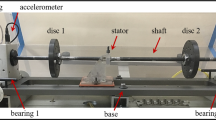Abstract
The aim of this paper is to evaluate the theoretical efficiency of optimal propellers by means of a variational approach; non classical propellers are included in the analysis. A solution to the optimum rotor problem, in the context of propeller vortex theory, was given by Goldstein in 1929; in this paper, a variational formulation of the optimum rotor problem is proposed. The formulation consists into finding a class of functions (the circulation along the blade axis) for which the thrust and drag momentum functionals are well defined; in this class, the functional is proved to be strictly convex and, thus, the global minimum exists and is unique. Some configurations are analysed using the Ritz method: classical straight blade, parabolic blade, elliptical blade; single and multiple blade propellers are compared.
Similar content being viewed by others
References
W. J. M. Rankine, Transactions, Institute of Naval Architects, vol. 6, p. 13, 1865.
W. Froude, Transactions, Institute of Naval Architects, vol. 19, p. 47, 1878.
A. Betz, L. Prandtl, “Schraubenpropeller mit geringstem Energieverlust”, Göttingen State and University Library, 1919.
E. Pistolesi, “La teoria dei vortici in aerodinamica”, L’Aeronautica, IV, 4 Apr. 1932.
N. Y. Joukowsky, “Theorie turbillonaire de l’hélice propulsive”, Guathier-Villars, Paris 1929.
S. Goldstein, “On the vortex theory of screw propellers”, Royal Society of London, Series A, 1929.
H. Glauert, “Airplane Propellers”, Aerodynamic Theory (W. F. Durand, Editor-in-chief), vol. 6, Division L, p. 324, Julius Springer, Berlin 1935.
C. Lock, “Application of Goldstein’s Airscrew Theory to Design”, Aeronautical Research Committee, RM 1377, Nov. 1930.
T. Theodorsen, “Theory of Propellers”, McGraw-Hill, 1948.
E. Larrabea, “The Screw Propeller”, Scientific American, vol. 243, n. 1, pp. 134–148, 1980.
C. Adkins, R. Liebeck, “Design of Optimum Propellers”, Journal of Propulsion and Power, vol. 10, n. 5, pp. 676–682, Sept.-Oct. 1994.
J. Dorfling, K. Rokhsaz, “Constrained and Unconstrained Propeller Blade Optimization”, Journal of Aircraft, vol. 52, n. 4, Jul.-Aug. 2015.
J. J. Chattot, “Optimization of propellers using helicoidal vortex model”, Computational Fluid Dynamics Journal, Vol. 9, No. 2, Jul. 2000.
J. J. Chattot, “Design and analysis of wind turbine using helicoidal vortex model”, Computational Fluid Dynamics Journal, Vol. 11, No. 1, Apr. 2002.
V. L. Okulov, Journal of Fluid Mechanics, vol. 521, pp. 319–342, 2004.
V. L. Okulov, J. N. Sorensen, “Optimum operating regimes for ideal wind turbine”, Journal of Physics, Conference Series 75, 2007.
J. B. Blair, D. M. Mark, “Inviscid Analysis of Horizontal-Axis Wind Turbines Using Distributed Vorticity Elements”, AIAA, 2011.
C. D. Paxton, P. J. Gryn, E. K. Hines, “High efficiency forward swept propellers at low speed”, AIAA, 2003.
R. Avellàn, A. Lundbladh, “Boxprop, a forward-swept joined-blade propeller”, AIAA, 2013.
E. Pistolesi, “Aerodinamica”, UTET, 1932.
R. Tognaccini, “Lezioni di aerodinamica dell’ala rotante”, Università degli Studi di Napoli Federico II, 2008–2009.
C. L. Tibery and J. W. Wrench, “Tables of Goldstein factor”, report 1534, Applied Mathematics Laboratory, Washington DC, 1964.
F. Tricomi, “Equazioni integrali contenenti il valor principale di un integrale doppio”, Mathematische Zeitschrift, 1928, Vol. 27, pp. 87–133.
M. T. Panaro, A. Frediani, F. Giannessi, E. Rizzo, “Variational approach to the problem of the minimum induced drag of wings”, Springer, Variational Analysis and Aerospace Engineering, pp. 313–342, 2009.
L. E. Elsgolc, “Calculus of variation”, Pergamon Press, 1961.
L. Demasi, A. Dipace, G. Monegato, R. Cavallaro, “An Invariant formulation for the minimum induced dragcon ditions of non-planar wing systems”, AIAA, 2014.
G. Monegato, “The numerical evaluation of a 2-D Cauchy principal value integral arising in boundary integral equation methods”, AMS, Vol. 62, No. 206, pp. 765–777, Apr. 1994.
Author information
Authors and Affiliations
Rights and permissions
About this article
Cite this article
Torrigiani, F., Dipace, A. & Frediani, A. Variational Approach to the Problem of the Optimal Propeller Design. Aerotec. Missili Spaz. 95, 13–23 (2016). https://doi.org/10.1007/BF03404710
Published:
Issue Date:
DOI: https://doi.org/10.1007/BF03404710




